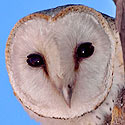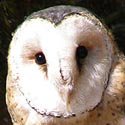|
Family: Tytonidae (Barn owl, Grass owl)
Life
> Eukaryotes >
Opisthokonta
> Metazoa (animals) >
Bilateria >
Deuterostomia > Chordata >
Craniata > Vertebrata (vertebrates) > Gnathostomata (jawed
vertebrates) > Teleostomi (teleost fish) > Osteichthyes (bony fish) > Class:
Sarcopterygii (lobe-finned
fish) > Stegocephalia (terrestrial
vertebrates) > Tetrapoda
(four-legged vertebrates) > Reptiliomorpha > Amniota >
Reptilia (reptiles) >
Romeriida > Diapsida > Archosauromorpha > Archosauria >
Dinosauria
(dinosaurs) > Saurischia > Theropoda (bipedal predatory dinosaurs) >
Coelurosauria > Maniraptora > Aves
(birds) > Order: Strigiformes
Species indigenous to southern Africa
|
Tyto alba
(Barn owl) The Barn owl has the widest
distribution of any owl and is found in every continent except Antarctica.
It's often associated with deserted buildings, as it uses them as roosting
sites. It preys mainly on small mammals and birds, although termites have
been recorded in its diet. The female incubates the eggs while the male hunts. Incubation starts
with the first egg, which means that there are chicks of different
ages in one nest. Older chicks sometimes feed
their younger siblings and, when food is scarce, sometimes resort to eating
the younger chicks. |
 |
|
Tyto
capensis (African grass-owl) |
 |
|
